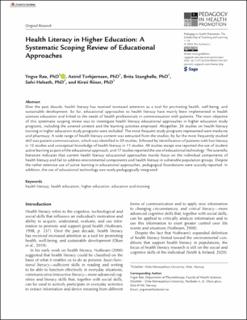| dc.contributor.author | Røe, Yngve | |
| dc.contributor.author | Torbjørnsen, Astrid | |
| dc.contributor.author | Stanghelle, Brita | |
| dc.contributor.author | Helseth, Sølvi | |
| dc.contributor.author | Riiser, Kirsti | |
| dc.date.accessioned | 2023-08-09T08:33:25Z | |
| dc.date.available | 2023-08-09T08:33:25Z | |
| dc.date.created | 2023-08-07T08:24:51Z | |
| dc.date.issued | 2023 | |
| dc.identifier.issn | 2373-3799 | |
| dc.identifier.issn | 2373-3802 | |
| dc.identifier.uri | https://hdl.handle.net/11250/3083150 | |
| dc.description.abstract | Over the past decade, health literacy has received increased attention as a tool for promoting health, well-being, and sustainable development. So far, educational approaches to health literacy have mainly been implemented in health sciences education and linked to the needs of health professionals in communication with patients. The main objective of this systematic scoping review was to investigate health literacy educational approaches in higher education study programs, including the covered content and the learning activities employed. Altogether, 26 studies on health literacy training in higher education study programs were included. The most frequent study programs represented were medicine and pharmacy. A wide range of health literacy content was extracted from the studies; by far the most frequently studied skill was patient communication, which was identified in 20 studies, followed by identification of patients with low literacy in 12 studies and conceptual knowledge of health literacy in 11 studies. All studies except one reported the use of student active learning as part of the educational approach, and 17 studies reported the use of educational technology. The scientific literature indicates that current health literacy educational approaches mainly focus on the individual components of health literacy and fail to address environmental components and health literacy in vulnerable population groups. Despite the rather extensive use of active learning in educational approaches, pedagogical foundations were scarcely reported. In addition, the use of educational technology was rarely pedagogically integrated. | en_US |
| dc.language.iso | eng | en_US |
| dc.publisher | SAGE Publications | en_US |
| dc.relation.ispartofseries | Pedagogy in health promotion; | |
| dc.relation.uri | https://journals.sagepub.com/doi/10.1177/23733799231191107 | |
| dc.rights | Navngivelse 4.0 Internasjonal | * |
| dc.rights.uri | http://creativecommons.org/licenses/by/4.0/deed.no | * |
| dc.title | Health Literacy in Higher Education: A Systematic Scoping Review of Educational Approaches | en_US |
| dc.type | Peer reviewed | en_US |
| dc.type | Journal article | en_US |
| dc.description.version | publishedVersion | en_US |
| cristin.ispublished | true | |
| cristin.fulltext | original | |
| cristin.qualitycode | 1 | |
| dc.identifier.doi | https://doi.org/10.1177/23733799231191107 | |
| dc.identifier.cristin | 2165126 | |
| dc.source.journal | Pedagogy in health promotion | en_US |
| dc.source.pagenumber | 1-10 | en_US |

